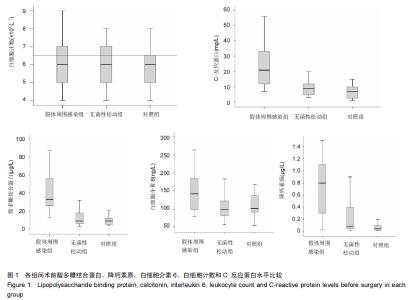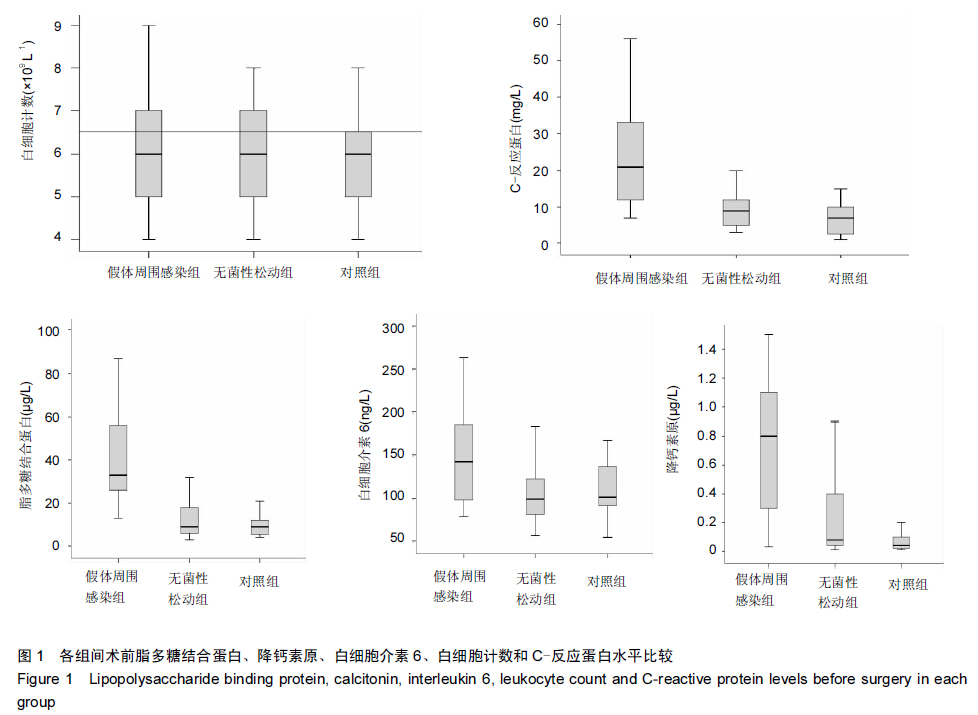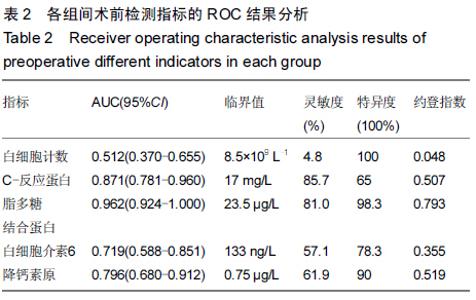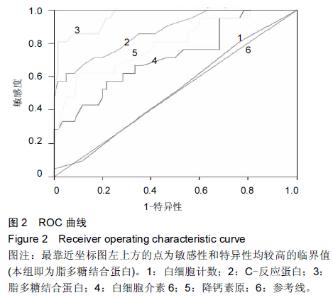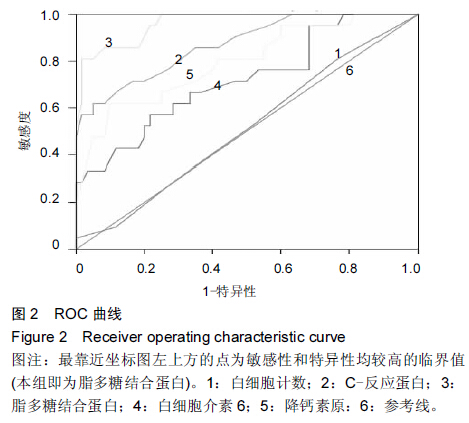Chinese Journal of Tissue Engineering Research ›› 2015, Vol. 19 ›› Issue (44): 7097-7102.doi: 10.3969/j.issn.2095-4344.2015.44.009
Previous Articles Next Articles
Different biomarkers predict periprosthetic joint infection and aseptic loosening after joint arthroplasty
Zhang Yu-ge, Wang Guo-dong, Zhang Yuan-min, Zhao Xiao-wei, Niu Shuai-shuai
- Department of Joint Surgery, Affiliated Hospital of Jining Medical College, Jining 272029, Shandong Province, China
-
Received:2015-08-17Online:2015-10-22Published:2015-10-22 -
About author:Zhang Yu-ge, Nurse-in-charge, Department of Joint Surgery, Affiliated Hospital of Jining Medical College, Jining 272029, Shandong Province, China -
Supported by:the Natural Science Foundation of Shandong Province, No. ZR2010HQ036
Cite this article
Zhang Yu-ge, Wang Guo-dong, Zhang Yuan-min, Zhao Xiao-wei, Niu Shuai-shuai . Different biomarkers predict periprosthetic joint infection and aseptic loosening after joint arthroplasty[J]. Chinese Journal of Tissue Engineering Research, 2015, 19(44): 7097-7102.
share this article
| [1] Berbari E, Mabry T, Tsaras G, et al. Inflammatory blood laboratory levels as markers of prosthetic joint infection: a systematic review and meta analysis. J Bone Joint Surg (Am). 2010;92:2102-2109. [2] Gollwitzer H, Dombrowski Y, Prodinger PM, et al. Antimicrobial peptides and proinflammatory cytokines periprosthetic joint infection. J Bone Joint Surg (Am). 2013;95: 644-651.
[3] 窦超,赵林,武星.关节置换术后感染与降钙素原的关系探讨[J].中华医院感染学杂志,2011,21(17):3578-3580.
[4] Parvizi J, Zmistowski B, Berbari EF, et al. New definition for periprosthetic joint infection: from the Workgroup of the Musculoskeletal Infection Society. Clin Orthop Relat Res. 2011;469:2992-2994.
[5] Bottner F, Wegner A, Winkelmann W, et al. Interleukin-6, procalcitonin and TNF-alpha: markers of peri- prosthetic infection following total joint replacement. J Bone Joint Surg (Br).2007;89:94-99.
[6] Fottner A, Birkenmaier C, von Schulze Pellengahr C, et al. Can serum procalcitonin help to differentiate between septic and nonseptic arthritis? Arthroscopy.2008; 24:229-233.
[7] Parvizi J, Zmistowski B, Berbari EF, et al. New definition for periprosthetic joint infection: from the Workgroup of the Musculoskeletal Infection Society. Clin Orthop Relat Res. 2011;469:2992-2994.
[8] Janz V, Wassilew GI, Hasart O, et al. Evaluation of sonicate fluid cultures in comparison to histological analysis of the periprosthetic membrane for detecting periprosthetic joint infection. Int Orthop. 2013; 37:931-936.
[9] Worthington T, Dunlop D, Casey A, et al. Serum procalcitonin, interleukin-6, soluble intercellular adhesin molecule-1 and IgG to short-chain exocellular lipotei- choic acid as predictors of infection in total joint prosthesis revision. Br J Biomed Sci. 2010;67:71-76.
[10] Bozic KJ, Rubash HE. The painful total hip replacement. Clin Orthop Relat Res. 2004;420:18-25.
[11] Whitehouse MR, Endo M, Zachara S,et al. Adverse local tissue reactions in metal-on-polyethylene total hip arthroplasty due to trunnion corrosion: the risk of misdiagnosis. Bone Joint J. 2015;97-B(8):1024-1030.
[12] Markatos K, Kaseta M, Nikolaou VS. Perioperative Skin Preparation and Draping in Modern Total Joint Arthroplasty: Current Evidence.Surg Infect (Larchmt). 2015;16(3):221-225.
[13] Lee JK, Kee YM, Chung HK, et al. Long-term results of cruciate-retaining total knee replacement in patients with rheumatoid arthritis: a minimum 15-year review. Can J Surg. 2015;58(3):193-197.
[14] Daines BK, Dennis DA, Amann S. Infection prevention in total knee arthroplasty. J Am Acad Orthop Surg. 2015;23(6): 356-364.
[15] Reinisch G, Huber M, Zweymüller KA. Low-Carbon Metal-on-Metal Articulations for Hip Arthroplasties-Evaluation of Wear and Histology after 11 to 17 Years. Z Orthop Unfall. 2015;153(4):392-398.
[16] Daines BK, Dennis DA, Amann S. Infection prevention in total knee arthroplasty. J Am Acad Orthop Surg. 2015;23(6): 356-364.
[17] Bernard L, Lubbeke A, Stern R, et al. Value of preoperative investigations in diagnosing prosthetic joint infection: retrospective cohort study and literature review. Scand J Infect Dis. 2004;36:410-416.
[18] Claassen L, Plaass C, Daniilidis K, et al. Two-stage revision total knee arthroplasty in cases of periprosthetic joint infection: an analysis of 50 cases. Open Orthop J. 2015;9:49-56.
[19] Springer BD. The Diagnosis of Periprosthetic Joint Infection.J Arthroplasty. 2015;30(6):908-911.
[20] Parvizi J, Alijanipour P, Barberi EF, et al. Novel developments in the prevention, diagnosis, and treatment of periprosthetic joint infections. J Am Acad Orthop Surg. 2015;23 Suppl: S32-43.
[21] Volpe L, Indelli PF, Latella L, et al. Periprosthetic joint infections: a clinical practice algorithm. Joints. 2015;2(4): 169-174.
[22] Lenski M, Scherer MA. Diagnostic potential of inflammatory markers in septic arthritis and periprosthetic joint infections: a clinical study with 719 patients. Infect Dis (Lond). 2015;47(6): 399-409.
[23] Ji HM, Ha YC, Baek JH, et al. Advantage of minimal anterior knee pain and long-term survivorship of cemented single radius posterior-stabilized total knee arthroplasty without patella resurfacing. Clin Orthop Surg. 2015;7(1):54-61.
[24] Glehr M, Friesenbichler J, Hofmann G, et al.Novel biomarkers to detect infection in revision hip and knee arthroplasties. Clin Orthop Relat Res. 2013;471:2621-2628.
[25] Alijanipour P, Bakhshi H, Parvizi J. Diagnosis of periprosthetic joint infection: the threshold for serological markers. Clin Orthop Relat Res. 2013;471:3186-3195.
[26] Parvizi J, McKenzie JC, Cashman JP. Diagnosis of periprosthetic joint infection using synovial C-reactive protein. J Arthroplast. 2012;27:12-16.
[27] Diaz-Ledezma C, Lamberton C, Lichstein P, et al. Diagnosis of Periprosthetic Joint Infection: The Role of Nuclear Medicine May Be Overestimated. J Arthroplasty. 2015;30(6): 1044-1049.
[28] Frangiamore SJ, Saleh A, Grosso MJ, et al. α-Defensin as a predictor of periprosthetic shoulder infection.J Shoulder Elbow Surg. 2015;24(7):1021-1027.
[29] Yuan K, Li WD, Qiang Y, et al. Comparison of procalcitonin and C-reactive protein for the diagnosis of periprosthetic jointinfection before revision total hip arthroplasty. Surg Infect (Larchmt). 2015;16(2):146-150.
[30] Omar M, Ettinger M, Reichling M, et al. Synovial C-reactive protein as a marker for chronic periprosthetic infection in total hip arthroplasty. Bone Joint J. 2015;97-B(2):173-176.
[31] Shahi A, Deirmengian C, Higuera C, et al. Premature Therapeutic Antimicrobial Treatments Can Compromise the Diagnosis of Late Periprosthetic Joint Infection.Clin Orthop Relat Res. 2015;473(7):2244-2249.
[32] Parvizi J, Adeli B, Zmistowski B, et al. Management of periprosthetic joint infection: the current knowledge: AAOS exhibit selection. J Bone Joint Surg Am. 2012; 94(14):e104.
[33] Parvizi J, Jacovides C, Antoci V, et al. Diagnosis of Periprosthetic Joint Infection: The Utility of a Simple Yet Unappreciated Enzyme J Bone Joint Surg Am. 2011; 93(24): 2242- 2248.
|
| [1] | Zhang Tongtong, Wang Zhonghua, Wen Jie, Song Yuxin, Liu Lin. Application of three-dimensional printing model in surgical resection and reconstruction of cervical tumor [J]. Chinese Journal of Tissue Engineering Research, 2021, 25(9): 1335-1339. |
| [2] | Yuan Jiawei, Zhang Haitao, Jie Ke, Cao Houran, Zeng Yirong. Underlying targets and mechanism of Taohong Siwu Decoction in prosthetic joint infection on network pharmacology [J]. Chinese Journal of Tissue Engineering Research, 2021, 25(9): 1428-1433. |
| [3] | Zeng Yanhua, Hao Yanlei. In vitro culture and purification of Schwann cells: a systematic review [J]. Chinese Journal of Tissue Engineering Research, 2021, 25(7): 1135-1141. |
| [4] | Hua Haotian, Zhao Wenyu, Zhang Lei, Bai Wenbo, Wang Xinwei. Meta-analysis of clinical efficacy and safety of antibiotic artificial bone in the treatment of chronic osteomyelitis [J]. Chinese Journal of Tissue Engineering Research, 2021, 25(6): 970-976. |
| [5] | Xu Dongzi, Zhang Ting, Ouyang Zhaolian. The global competitive situation of cardiac tissue engineering based on patent analysis [J]. Chinese Journal of Tissue Engineering Research, 2021, 25(5): 807-812. |
| [6] | Wu Zijian, Hu Zhaoduan, Xie Youqiong, Wang Feng, Li Jia, Li Bocun, Cai Guowei, Peng Rui. Three-dimensional printing technology and bone tissue engineering research: literature metrology and visual analysis of research hotspots [J]. Chinese Journal of Tissue Engineering Research, 2021, 25(4): 564-569. |
| [7] | Chang Wenliao, Zhao Jie, Sun Xiaoliang, Wang Kun, Wu Guofeng, Zhou Jian, Li Shuxiang, Sun Han. Material selection, theoretical design and biomimetic function of artificial periosteum [J]. Chinese Journal of Tissue Engineering Research, 2021, 25(4): 600-606. |
| [8] | Liu Fei, Cui Yutao, Liu He. Advantages and problems of local antibiotic delivery system in the treatment of osteomyelitis [J]. Chinese Journal of Tissue Engineering Research, 2021, 25(4): 614-620. |
| [9] | Li Xiaozhuang, Duan Hao, Wang Weizhou, Tang Zhihong, Wang Yanghao, He Fei. Application of bone tissue engineering materials in the treatment of bone defect diseases in vivo [J]. Chinese Journal of Tissue Engineering Research, 2021, 25(4): 626-631. |
| [10] | Zhang Zhenkun, Li Zhe, Li Ya, Wang Yingying, Wang Yaping, Zhou Xinkui, Ma Shanshan, Guan Fangxia. Application of alginate based hydrogels/dressings in wound healing: sustained, dynamic and sequential release [J]. Chinese Journal of Tissue Engineering Research, 2021, 25(4): 638-643. |
| [11] | Chen Jiana, Qiu Yanling, Nie Minhai, Liu Xuqian. Tissue engineering scaffolds in repairing oral and maxillofacial soft tissue defects [J]. Chinese Journal of Tissue Engineering Research, 2021, 25(4): 644-650. |
| [12] | Ma Rui, Wang Jialin, Wu Mengjun, Ge Ying, Wang Wei, Wang Kunzheng. Relationship of pathogenic bacteria distribution with drug resistance and treatment cycle for periprosthetic joint infection after total joint arthroplasty [J]. Chinese Journal of Tissue Engineering Research, 2021, 25(3): 380-385. |
| [13] | Xing Hao, Zhang Yonghong, Wang Dong. Advantages and disadvantages of repairing large-segment bone defect [J]. Chinese Journal of Tissue Engineering Research, 2021, 25(3): 426-430. |
| [14] | Liu Jianyou, Jia Zhongwei, Niu Jiawei, Cao Xinjie, Zhang Dong, Wei Jie. A new method for measuring the anteversion angle of the femoral neck by constructing the three-dimensional digital model of the femur [J]. Chinese Journal of Tissue Engineering Research, 2021, 25(24): 3779-3783. |
| [15] | Cheng Chongjie, Yan Yan, Zhang Qidong, Guo Wanshou. Diagnostic value and accuracy of D-dimer in periprosthetic joint infection: a systematic review and meta-analysis [J]. Chinese Journal of Tissue Engineering Research, 2021, 25(24): 3921-3928. |
| Viewed | ||||||
|
Full text |
|
|||||
|
Abstract |
|
|||||


